Zijian Cai
CanonSwap: High-Fidelity and Consistent Video Face Swapping via Canonical Space Modulation
Jul 03, 2025Abstract:Video face swapping aims to address two primary challenges: effectively transferring the source identity to the target video and accurately preserving the dynamic attributes of the target face, such as head poses, facial expressions, lip-sync, \etc. Existing methods mainly focus on achieving high-quality identity transfer but often fall short in maintaining the dynamic attributes of the target face, leading to inconsistent results. We attribute this issue to the inherent coupling of facial appearance and motion in videos. To address this, we propose CanonSwap, a novel video face-swapping framework that decouples motion information from appearance information. Specifically, CanonSwap first eliminates motion-related information, enabling identity modification within a unified canonical space. Subsequently, the swapped feature is reintegrated into the original video space, ensuring the preservation of the target face's dynamic attributes. To further achieve precise identity transfer with minimal artifacts and enhanced realism, we design a Partial Identity Modulation module that adaptively integrates source identity features using a spatial mask to restrict modifications to facial regions. Additionally, we introduce several fine-grained synchronization metrics to comprehensively evaluate the performance of video face swapping methods. Extensive experiments demonstrate that our method significantly outperforms existing approaches in terms of visual quality, temporal consistency, and identity preservation. Our project page are publicly available at https://luoxyhappy.github.io/CanonSwap/.
Unveiling the Hidden: Movie Genre and User Bias in Spoiler Detection
Apr 28, 2025Abstract:Spoilers in movie reviews are important on platforms like IMDb and Rotten Tomatoes, offering benefits and drawbacks. They can guide some viewers' choices but also affect those who prefer no plot details in advance, making effective spoiler detection essential. Existing spoiler detection methods mainly analyze review text, often overlooking the impact of movie genres and user bias, limiting their effectiveness. To address this, we analyze movie review data, finding genre-specific variations in spoiler rates and identifying that certain users are more likely to post spoilers. Based on these findings, we introduce a new spoiler detection framework called GUSD (The code is available at https://github.com/AI-explorer-123/GUSD) (Genre-aware and User-specific Spoiler Detection), which incorporates genre-specific data and user behavior bias. User bias is calculated through dynamic graph modeling of review history. Additionally, the R2GFormer module combines RetGAT (Retentive Graph Attention Network) for graph information and GenreFormer for genre-specific aggregation. The GMoE (Genre-Aware Mixture of Experts) model further assigns reviews to specialized experts based on genre. Extensive testing on benchmark datasets shows that GUSD achieves state-of-the-art results. This approach advances spoiler detection by addressing genre and user-specific patterns, enhancing user experience on movie review platforms.
GridShow: Omni Visual Generation
Dec 17, 2024Abstract:In this paper, we introduce GRID, a novel paradigm that reframes a broad range of visual generation tasks as the problem of arranging grids, akin to film strips. At its core, GRID transforms temporal sequences into grid layouts, enabling image generation models to process visual sequences holistically. To achieve both layout consistency and motion coherence, we develop a parallel flow-matching training strategy that combines layout matching and temporal losses, guided by a coarse-to-fine schedule that evolves from basic layouts to precise motion control. Our approach demonstrates remarkable efficiency, achieving up to 35 faster inference speeds while using 1/1000 of the computational resources compared to specialized models. Extensive experiments show that GRID exhibits exceptional versatility across diverse visual generation tasks, from Text-to-Video to 3D Editing, while maintaining its foundational image generation capabilities. This dual strength in both expanded applications and preserved core competencies establishes GRID as an efficient and versatile omni-solution for visual generation.
SSAD: Self-supervised Auxiliary Detection Framework for Panoramic X-ray based Dental Disease Diagnosis
Jun 20, 2024Abstract:Panoramic X-ray is a simple and effective tool for diagnosing dental diseases in clinical practice. When deep learning models are developed to assist dentist in interpreting panoramic X-rays, most of their performance suffers from the limited annotated data, which requires dentist's expertise and a lot of time cost. Although self-supervised learning (SSL) has been proposed to address this challenge, the two-stage process of pretraining and fine-tuning requires even more training time and computational resources. In this paper, we present a self-supervised auxiliary detection (SSAD) framework, which is plug-and-play and compatible with any detectors. It consists of a reconstruction branch and a detection branch. Both branches are trained simultaneously, sharing the same encoder, without the need for finetuning. The reconstruction branch learns to restore the tooth texture of healthy or diseased teeth, while the detection branch utilizes these learned features for diagnosis. To enhance the encoder's ability to capture fine-grained features, we incorporate the image encoder of SAM to construct a texture consistency (TC) loss, which extracts image embedding from the input and output of reconstruction branch, and then enforces both embedding into the same feature space. Extensive experiments on the public DENTEX dataset through three detection tasks demonstrate that the proposed SSAD framework achieves state-of-the-art performance compared to mainstream object detection methods and SSL methods. The code is available at https://github.com/Dylonsword/SSAD
MMoE: Robust Spoiler Detection with Multi-modal Information and Domain-aware Mixture-of-Experts
Mar 14, 2024



Abstract:Online movie review websites are valuable for information and discussion about movies. However, the massive spoiler reviews detract from the movie-watching experience, making spoiler detection an important task. Previous methods simply focus on reviews' text content, ignoring the heterogeneity of information in the platform. For instance, the metadata and the corresponding user's information of a review could be helpful. Besides, the spoiler language of movie reviews tends to be genre-specific, thus posing a domain generalization challenge for existing methods. To this end, we propose MMoE, a multi-modal network that utilizes information from multiple modalities to facilitate robust spoiler detection and adopts Mixture-of-Experts to enhance domain generalization. MMoE first extracts graph, text, and meta feature from the user-movie network, the review's textual content, and the review's metadata respectively. To handle genre-specific spoilers, we then adopt Mixture-of-Experts architecture to process information in three modalities to promote robustness. Finally, we use an expert fusion layer to integrate the features from different perspectives and make predictions based on the fused embedding. Experiments demonstrate that MMoE achieves state-of-the-art performance on two widely-used spoiler detection datasets, surpassing previous SOTA methods by 2.56% and 8.41% in terms of accuracy and F1-score. Further experiments also demonstrate MMoE's superiority in robustness and generalization.
LMBot: Distilling Graph Knowledge into Language Model for Graph-less Deployment in Twitter Bot Detection
Jul 03, 2023Abstract:As malicious actors employ increasingly advanced and widespread bots to disseminate misinformation and manipulate public opinion, the detection of Twitter bots has become a crucial task. Though graph-based Twitter bot detection methods achieve state-of-the-art performance, we find that their inference depends on the neighbor users multi-hop away from the targets, and fetching neighbors is time-consuming and may introduce bias. At the same time, we find that after finetuning on Twitter bot detection, pretrained language models achieve competitive performance and do not require a graph structure during deployment. Inspired by this finding, we propose a novel bot detection framework LMBot that distills the knowledge of graph neural networks (GNNs) into language models (LMs) for graph-less deployment in Twitter bot detection to combat the challenge of data dependency. Moreover, LMBot is compatible with graph-based and graph-less datasets. Specifically, we first represent each user as a textual sequence and feed them into the LM for domain adaptation. For graph-based datasets, the output of LMs provides input features for the GNN, enabling it to optimize for bot detection and distill knowledge back to the LM in an iterative, mutually enhancing process. Armed with the LM, we can perform graph-less inference, which resolves the graph data dependency and sampling bias issues. For datasets without graph structure, we simply replace the GNN with an MLP, which has also shown strong performance. Our experiments demonstrate that LMBot achieves state-of-the-art performance on four Twitter bot detection benchmarks. Extensive studies also show that LMBot is more robust, versatile, and efficient compared to graph-based Twitter bot detection methods.
Enhancing Model Performance in Multilingual Information Retrieval with Comprehensive Data Engineering Techniques
Feb 14, 2023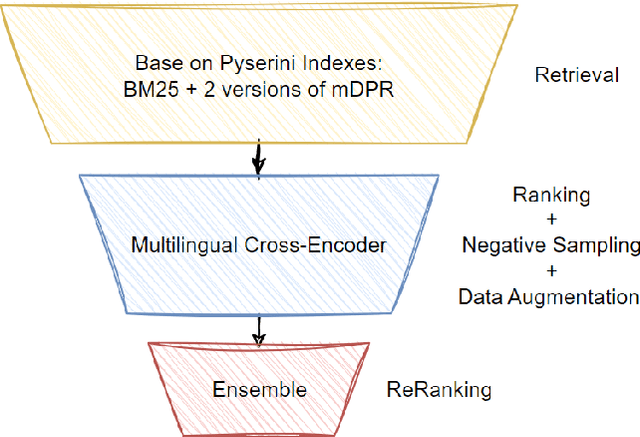
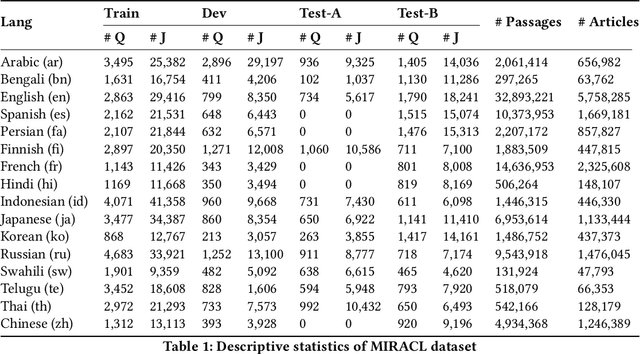


Abstract:In this paper, we present our solution to the Multilingual Information Retrieval Across a Continuum of Languages (MIRACL) challenge of WSDM CUP 2023\footnote{https://project-miracl.github.io/}. Our solution focuses on enhancing the ranking stage, where we fine-tune pre-trained multilingual transformer-based models with MIRACL dataset. Our model improvement is mainly achieved through diverse data engineering techniques, including the collection of additional relevant training data, data augmentation, and negative sampling. Our fine-tuned model effectively determines the semantic relevance between queries and documents, resulting in a significant improvement in the efficiency of the multilingual information retrieval process. Finally, Our team is pleased to achieve remarkable results in this challenging competition, securing 2nd place in the Surprise-Languages track with a score of 0.835 and 3rd place in the Known-Languages track with an average nDCG@10 score of 0.716 across the 16 known languages on the final leaderboard.
Using Deep Mixture-of-Experts to Detect Word Meaning Shift for TempoWiC
Nov 07, 2022



Abstract:This paper mainly describes the dma submission to the TempoWiC task, which achieves a macro-F1 score of 77.05% and attains the first place in this task. We first explore the impact of different pre-trained language models. Then we adopt data cleaning, data augmentation, and adversarial training strategies to enhance the model generalization and robustness. For further improvement, we integrate POS information and word semantic representation using a Mixture-of-Experts (MoE) approach. The experimental results show that MoE can overcome the feature overuse issue and combine the context, POS, and word semantic features well. Additionally, we use a model ensemble method for the final prediction, which has been proven effective by many research works.
A Semantic Alignment System for Multilingual Query-Product Retrieval
Aug 05, 2022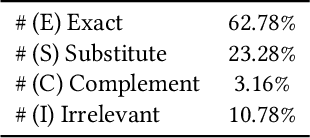
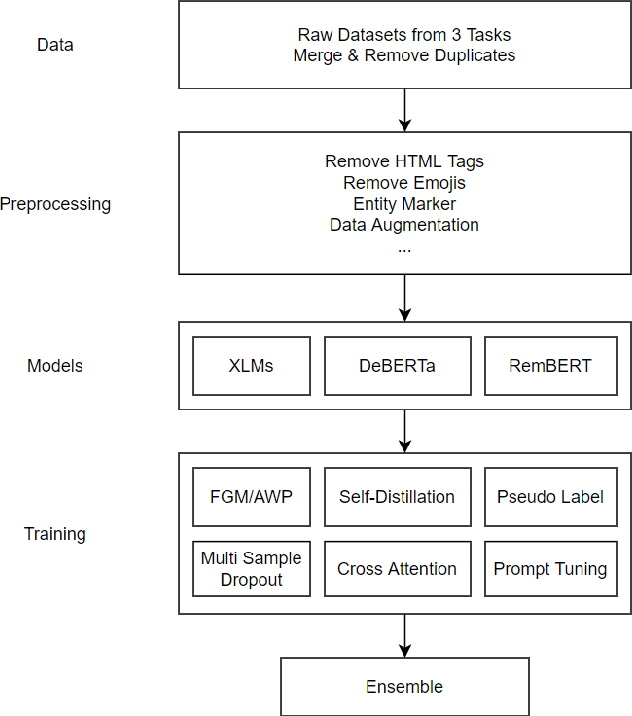
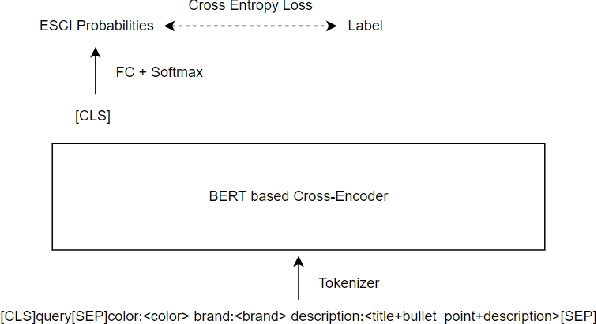
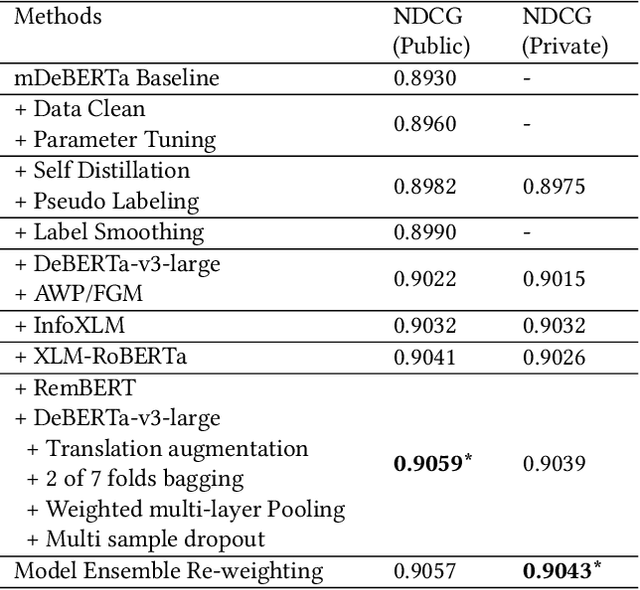
Abstract:This paper mainly describes our winning solution (team name: www) to Amazon ESCI Challenge of KDD CUP 2022, which achieves a NDCG score of 0.9043 and wins the first place on task 1: the query-product ranking track. In this competition, participants are provided with a real-world large-scale multilingual shopping queries data set and it contains query-product pairs in English, Japanese and Spanish. Three different tasks are proposed in this competition, including ranking the results list as task 1, classifying the query/product pairs into Exact, Substitute, Complement, or Irrelevant (ESCI) categories as task 2 and identifying substitute products for a given query as task 3. We mainly focus on task 1 and propose a semantic alignment system for multilingual query-product retrieval. Pre-trained multilingual language models (LM) are adopted to get the semantic representation of queries and products. Our models are all trained with cross-entropy loss to classify the query-product pairs into ESCI 4 categories at first, and then we use weighted sum with the 4-class probabilities to get the score for ranking. To further boost the model, we also do elaborative data preprocessing, data augmentation by translation, specially handling English texts with English LMs, adversarial training with AWP and FGM, self distillation, pseudo labeling, label smoothing and ensemble. Finally, Our solution outperforms others both on public and private leaderboard.
TwiBot-22: Towards Graph-Based Twitter Bot Detection
Jun 12, 2022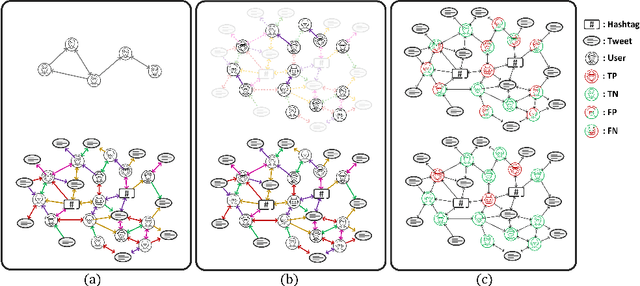


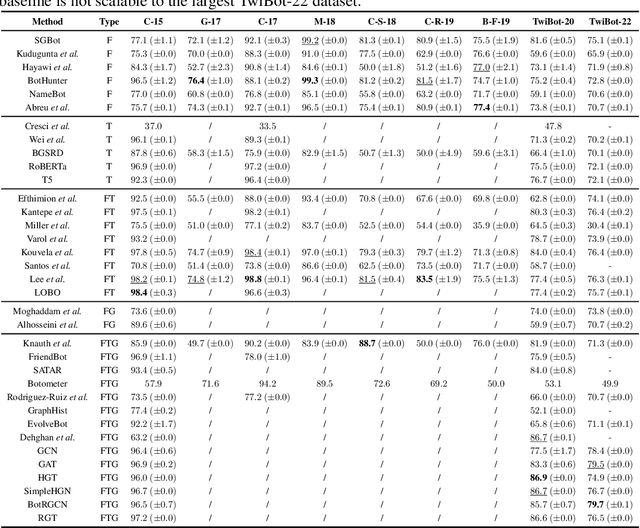
Abstract:Twitter bot detection has become an increasingly important task to combat misinformation, facilitate social media moderation, and preserve the integrity of the online discourse. State-of-the-art bot detection methods generally leverage the graph structure of the Twitter network, and they exhibit promising performance when confronting novel Twitter bots that traditional methods fail to detect. However, very few of the existing Twitter bot detection datasets are graph-based, and even these few graph-based datasets suffer from limited dataset scale, incomplete graph structure, as well as low annotation quality. In fact, the lack of a large-scale graph-based Twitter bot detection benchmark that addresses these issues has seriously hindered the development and evaluation of novel graph-based bot detection approaches. In this paper, we propose TwiBot-22, a comprehensive graph-based Twitter bot detection benchmark that presents the largest dataset to date, provides diversified entities and relations on the Twitter network, and has considerably better annotation quality than existing datasets. In addition, we re-implement 35 representative Twitter bot detection baselines and evaluate them on 9 datasets, including TwiBot-22, to promote a fair comparison of model performance and a holistic understanding of research progress. To facilitate further research, we consolidate all implemented codes and datasets into the TwiBot-22 evaluation framework, where researchers could consistently evaluate new models and datasets. The TwiBot-22 Twitter bot detection benchmark and evaluation framework are publicly available at https://twibot22.github.io/
 Add to Chrome
Add to Chrome Add to Firefox
Add to Firefox Add to Edge
Add to Edge